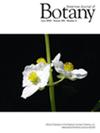Why are triploid quaking aspen (Populus tremuloides) common?
Abstract
Premise
Quaking aspen is a clonal tree species that has mixed ploidy, often with high relative abundance of both diploids and triploids but no haploids or tetraploids. Triploids typically have low fertility, leaving their occurrence apparently unlikely from an evolutionary perspective, unless they provide a “triploid bridge” to generating higher-fitness tetraploids—which are not observed in this species. This study focused on how triploidy can be maintained in quaking aspen.
Methods
A computational model was used to simulate gamete production, sexual reproduction, asexual reproduction, parent survival, and offspring survival in a population. All parameters were assumed to be cytotype-dependent and environment-independent. Sampling methods were used to identify parameter combinations consistent with observed cytotype frequencies.
Results
Many processes and parameter values were sufficient to yield a moderate frequency of triploids, and very few were necessary. The most plausible route involved higher triploid survival at the parent or offspring stage and limited unreduced gamete production by either diploid or triploid parents. Triploid fertility was helpful but not necessary.
Conclusions
The coexistence of diploids and triploids in quaking aspen is statistically likely and promoted by the existence of commonly observed, long-lived triploid clones. However, other mechanisms not captured by the model related to environmental variation could also occur. Further empirical data or more complex but difficult-to-parameterize models are needed to gain further insight.

 求助内容:
求助内容: 应助结果提醒方式:
应助结果提醒方式:


